Abstract.
Two methods for stroke segmentation from a global point of view are presented and compared. One is based on thinning methods and the other is based on contour curve fitting. For both cases an input image is binarized. For the former, Hilditch's method is used, then crossing points are sought, around which a domain is constructed. Outside the domain, a set of line segments are identified. These lines are connected and approximated by cubic B-spline curves. Smoothly connected lines are selected as segmented curves. This method works well for a limited class of crossing lines, which are shown experimentally. In the latter, a contour line is approximated by cubic B-spline curve, along which curvature is measured. According to the extreme points of the curvature graph, the contour line is segmented, based on which the line segment is obtained. Experimental results are shown for some difficult cases.
Similar content being viewed by others
Author information
Authors and Affiliations
Additional information
Received October 31, 1998 / Revised January 12, 1999
Rights and permissions
About this article
Cite this article
Nakajima, Y., Mori, S., Takegami, S. et al. Global methods for stroke segmentation. IJDAR 2, 19–23 (1999). https://doi.org/10.1007/s100320050032
Issue Date:
DOI: https://doi.org/10.1007/s100320050032
